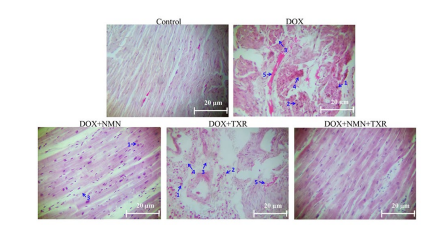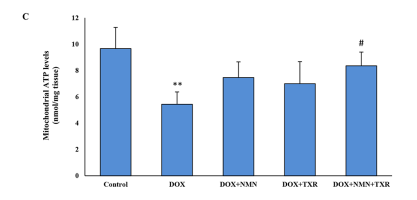Researchers Report that NMN Coupled with a Compound Found in Chinese Herb Fully Protects the Heart During Chemotherapy
By improving mitochondrial production and functional capacity, NMN with troxerutin fully protects the heart against the toxic effects of the chemotherapeutic doxorubicin in rats.
Highlights
- NMN coupled with a molecule found in buckwheat, troxerutin, fully protects the heart against tissue damage instigated by the chemotherapeutic agent doxorubicin.
- NMN and troxerutin combined preserve markers of mitochondrial health and new mitochondrial production to protect the heart during chemotherapy.
Doxorubicin is a chemotherapy drug used to treat cancers like lymphoma, leukemia, and breast cancer with a serious caveat; it damages the heart and raises the possibility of heart failure, especially at high doses. With research showing that the anti-aging supplement nicotinamide mononucleotide (NMN) and the buckwheat-derived compound troxerutin can protect the heart, could both molecules act in synergy to preserve the heart with doxorubicin treatment?
Published in Molecular Biology Reports, Badalzadeh and colleagues from Tabriz University in Iran demonstrate that combining NMN with troxerutin treatment fully protects the heart against doxorubicin-induced cardiotoxicity. The Iranian research team shows that treatment with doxorubicin alone adversely impacts heart tissue but treatment with NMN and troxerutin protect against doxorubicin-induced heart tissue malformations. NMN and troxerutin also preserve the function of mitochondria. Intriguingly, the most potent cardioprotective benefits from NMN and troxerutin occur when they are applied together. These findings imply that this combination of supplements may serve as a cardioprotective strategy to cancer patients undergoing chemotherapy.
Supplement Combo Preserves Cardiac Tissue
Badalzadeh and colleagues examined cardiac tissue structure and found that the combination of NMN and troxerutin nearly completely protects cardiac tissue against doxorubicin treatment. On the other hand, NMN or troxerutin on their own only offer some protective effects. These results suggest that combining the two compounds may provide complete cardio protection from the chemotherapeutic agent doxorubicin.

Research has shown that NMN and troxerutin protect cardiac tissue by enhancing mitochondrial function. Mitochondria function to produce cell energy molecules (adenosine triphosphate [ATP]) to keep heart cells alive. To do this efficiently, they must maintain their membrane potential — the voltage of the mitochondria. When mitochondria are damaged, their membrane potential can dissipate and they can no longer effectively produce ATP. With a less porous and more structurally intact membrane, mitochondria have higher membrane potentials and produce more ATP.
With this in mind, the Iranian researchers examined how NMN and troxerutin affect the mitochondrial membrane potential and ATP levels of heart cells exposed to doxorubicin, which reduces both. They found that the combo completely restores the membrane potential and ATP levels of mitochondria. These findings illustrate that the two compounds administered together synergistically preserve mitochondrial health in the face of doxorubicin treatment.


Mitochondria are damaged so often that they must constantly renew themselves through a process called mitochondrial biogenesis – the production of new mitochondria. There are several proteins associated with this process, of which Badalzadeh and colleagues measured in response to chemotherapy in cardiac muscle cells. Doxorubicin reduced the abundance of these proteins, but sure enough, administering NMN and troxerutin together nearly restored them. These findings point to NMN and troxerutin acting in synergy to protect cardiac function and overall healthy tissue integrity by promoting mitochondrial production.
“The results of our study disclosed that pretreatment of rats with NMN and [troxerutin], whether alone or in combination, reduced [doxorubicin]-induced heart damage,” said Badalzedeh and colleagues. “Interestingly, combination therapy induced superior cardio protection.”
Can the Supplement Combo Protect the Heart During Chemotherapy?As of yet, no studies other than this have examined troxerutin’s role in protecting cardiac cells against chemotherapy. There has been a study demonstrating NMN’s effectiveness, showing NMN preserves the heart during chemotherapy by reducing inflammation. However, this study did not provide data on the link between mitochondrial health and heart protection like the current study. Thus, even as more evidence accumulates, more experiments are needed. For example, a serious limitation to this study was that the Iranian research team did not examine NMN’s and troxerutin’s effects on cardiac function while undergoing doxorubicin treatment. Specifically, functional assays like blood pressure measurements at different points during the heartbeat would have been valuable to see whether these compounds restore heart function. Limitations aside, this study provides interesting evidence that by boosting mitochondrial function and new mitochondria production, NMN and possibly troxerutin can protect the heart muscle during chemotherapy.
Model: Wistar rats
Dosage: 2 mg/kg/48hr intraperitoneal injection of doxorubicin, 100 mg/kg/day intraperitoneal injection of NMN, 150 mg/kg/day intraperitoneal injection of troxerutin

